 | E-mail to Birds Korea |
 | KWBS |
in the Region
 | The Oriental Bird Club |
 | BirdLife International (Asia) |
April
One of the very best birdwatching months! Cold days and nights (lowest day maxima of ca 12°C) gradually warm through the month (reaching the low 20s°C by month's end), and dry spells interspersed with 1-2 days of heavy rain and stormy conditions produce great birding towards month's end.
Early in the month, late Hooded Crane move through while shorebird numbers and diversity start to build up, with up to 200 000 shorebirds in the Saemangeum area by the end of the month, including up to 60 000 Great Knot, and small numbers of the globally-endangered Nordmann's Greenshank and Spoon-billed Sandpiper. Other Korean specialities, include Chinese Egret from mid-month, and Black-faced Spoonbill in small groups along the west coast. This latter species only has a world population of around 1400! In early April, species like Brown-headed Thrush and Japanese Robin occur regularly in very small numbers in the far southwest and southeast, while mid-April sees the first large passerine arrivals and spring overshoots, with good counts of many species like Blue-and-white, Narcissus and Yellow-rumped Flycatchers, and Tristram's and Yellow-browed Buntings. Late in the month, 100 or more species a day are possible on the outer islands like Heuksan and Gageo in the far south, Eocheong off Gunsan, and Socheong to the northwest.
Highlights in April have included several firsts and many unusual records for Korea, including Caspian Tern in the Nakdong estuary in 2001, Ferruginous Flycatcher and Eurasian Crag Martin on Eocheong Island in 2002, Northern House Martin and Red-breasted Flycatcher on Eocheong in 2003, and a Paddyfield Warbler on Hong Island in 2004.
(The following records are a compilation of our own sightings and records sent in by other observers. As well as being posted on the Birds Korea website(s), selected records are also forwarded to other Korean-language birding websites; records of threatened species are arranged and forwarded to Birdlife International and national authorities when appropriate; flag images and records are passed to bodies responsible for their coordination throughout the flyway; and all records sent to us are used to compile annual reports and to support the evolving understanding of the status of many of Korea’s birds.)
Yanggu, April 30
An interesting day around Yanggu, with Yellow-browed Warblers and Tristram's Bunting recorded. Also the Chinese Pond Heron first seen last week is still present.
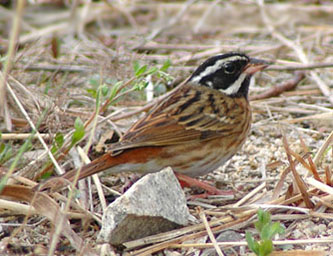

Weyeon-do, April 29
On the morning of 29th April, we counted Buntings Emberiza in Weyeon-do along the trekking road. We divided the road into 22 areas for counting.
The total number of Emberiza seen was 1520. More than twice that number might have been on the island, we suppose.
Approximate percentages of each species were about:
10% - Tristram's, less than 5% - Chestnut-eared, 10% - Little, 30% - Yellow-browed, less than 1% - Yellow-breasted, 45% - Black-faced, Meadow, Rustic, Yellow-throated, and Chestnut Buntings were seen in later days.
East Seoul, April 27
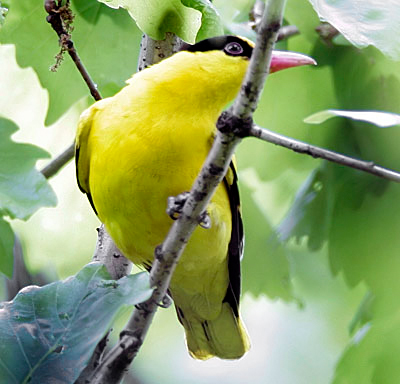
A patch of woods in the east side of Seoul is filling up with spring migrants: 1 Asian Brown and several Blue and White Flycatchers, 15 Tristram's Buntings, a Black-naped Oriole, 1 Rufous-tailed Robin and 2 Siberian Blue Robins, a Red-flanked Bluetail, several Large-billed Crows, 8 Yellow-browed and 2 Eastern Crowned Warblers, an Asian Stubtail, 3 Grey-backed, 2 Pale and 1 White's/Scaly Thrush, and a Grey-headed Woodpecker. With the setting sun, a calling Oriental Scops Owl.
POSTED 10 May: Most interesting bird was undoubtedly a Rufous-bellied Woodpecker that was first found by Korean birders on or around April 11th. [At the time Birds Korea was asked not to post this news or the following Photograph by the birders involved because of possible disturbance problems, which we of course agreed to.]

Photo © Robin Newlin

Photo © Robin Newlin
Dongjin Estuary, April 27
Three teams of counters covered the Dongjin and Gomso Bay. Counts from the inner Dongjin and Simpo area (2 teams) included a total of 28 204 shorebirds of 24 species, with most numerous being Great Knot (11 923), Dunlin (11 386), Bar-tailed Godwit (1 841), Grey Plover (1099), Mongolian Plover (532), Terek Sandpiper (300), Red-necked Stint (222) and Whimbrel (169), while species of special conservation concern included 4 Spoon-billed Sandpiper at Simpo, and 4 Nordmann's Greenshank, a breeding-plumaged Asiatic Dowitcher, a Black-faced Spoonbill and 8 Saunder's Gull in the inner Dongjin. Data from the third team will be added later.
Saemangeum: Life and Death - a study in contrasts:
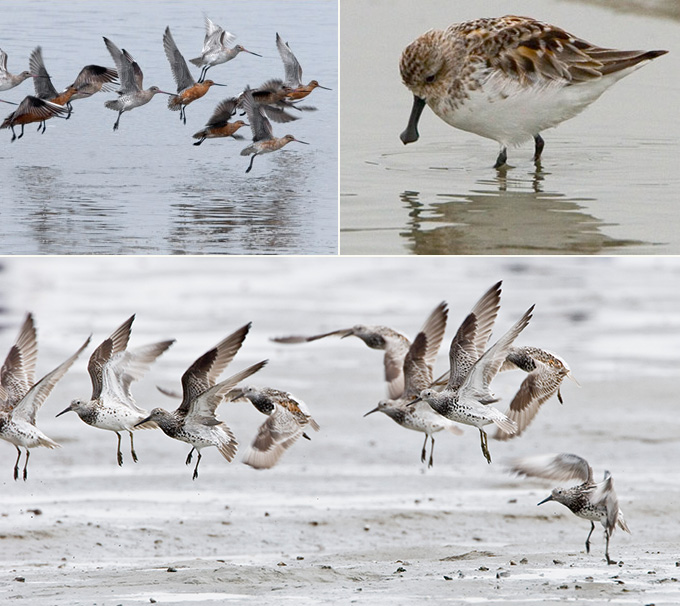
and Great Knots Calidris tenuirostris (bottom), Saemangeum, © Birds Korea/Jan van de Kam.

The impacts of the seawall closure are now, already, very apparent: large areas of saltmarsh and upper tidal-flat areas are dusted white with salt and "yellow dust", red algal blooms are appearing, while at Simpo abundant shells were gaping open in some areas, dying due to the lack of high tides... (Nial Moores, 27 April 2006)
Geum Estuary, April 26
With the start of the new spring tide cycle (and afternoon high tides of 6.5 m) four teams of counters covered the Geum estuary, with one team on Yubu, another on a neighboring island, and two teams on the mainland.
In total, at least 50, 575 shorebirds of 25 species recorded, with several species in internationally important concentrations. Most numerous were Dunlin (21 829), Great Knot (13,024), Bar-tailed Godwit (9 446), Grey Plover (2 735), Eastern Oystercatcher (1 255), Far Eastern Curlew (704), Mongolian Plover (533), Sanderling (198) and Ruddy Turnstone (187). While Grey-tailed Tattler (2) and Oriental Pratincole (1) were new for the Program, outstanding highlight was Nordmann's Greenshank, with 35 seen in a single scan by NM, and a further 5 counted on Yubu Island. 4 Black-faced Spoonbill and 10+ Saunders's Gull also noted.

For an interesting blog on the endangered Nordmann's Greenshank please go to
http://nordmannsgreenshank.blogspot.com/
Mangyeung Estuary, April 25
A day preparing for a more organised count later in the week, with 2 teams covering most of the Mangyeung Estuary.
Of greatest significance were that: (1) with the 580 m wide sluice gates open, there is still a small but significant tidal range within the Saemangeum system (probably of only 1.5 m, but still exposing vast tidal-flats); and (2) that remaining areas are still supporting huge numbers of shorebirds. Much more detailed count data will be posted later, but most numerous shorebird species recorded was Great Knot, with 57000 at Okku alone, with a total of ca 8,000 more found at two others sites.
Also of special note, there were 3 Nordmann's Greenshank and a breeding-plumaged Spoon-billed Sandpiper (DR) at the airport, and at least one Nordmann's Greenshank at Okku (where also a Chinese Egret and ca 4 Saunders's Gull).

East Seoul, April 25
A patch of deciduous woodland yielded some typical spring birds: 1 Yellow-browed and 2 (possibly) Pale-legged Leaf Warblers, 1 Red-flanked Bluetail, 2 Barn Swallows and 6 Pale Thrush. Resident birds included Grey-headed and Great-spotted Woodpecker, and Marsh & Long-tailed Tits.
Last remaining winter birds were 30+ Siskins and, surprisingly, 5 Japanese Waxwing.
Dong-mac station, Incheon, April 25

17 Black-faced Spoonbills (ie a little more than 1% of the world population!) found today on the small lake outside Dong-mac station
Eocheong Island, April 24 AM
A couple of hours birding in the morning produced 5 Greater Short-toed Lark, the Black-faced Spoonbill and Pied Wheatear and one Amur Falcon still, while personal firsts for the spring included a presumed Latham's Snipe, a Grey-tailed Tattler, and a breeding-plumaged Chinese Pond Heron.

Yanggu (forest, river and riparian areas), April 16 - 23
Passage migrant birds have been passing through Yanggu area, winter visitors leaving and summer visitors are arriving.
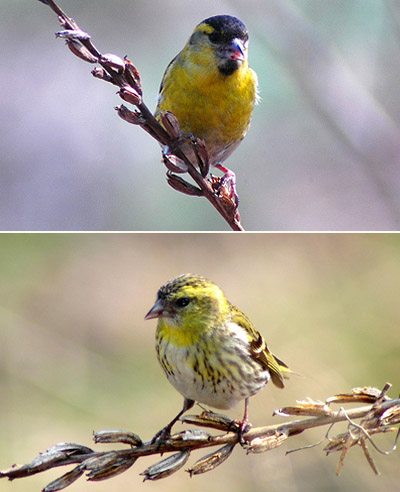
Photos © Barry Heinrich

April 16 I searched for birds along the west side of Seocheon, the small river that runs through Yanggu, and I recorded 49 bird species for the day. I heard 2 Korean Bush Warblers and saw a few winter visitors, probably passing through Yanggu. These included a pair of Mallards, three Tufted Ducks, a Wigeon, a Gadwall, a Falcated Teal and a Long-tailed Rosefinch. On the East side of the river I Photographed a Siberian Stonechat carrying nest material. Also found some Pallas' Reed Buntings and Little Buntings. At dusk a flock of about 150 White-fronted Geese flew over.
April 21 was a fine sunny day after 3 days of cold rainy weather. I saw a Black-winged Stilt in Yanggu-Seocheon as I was going to work, plus several Black-faced Buntings and Eastern Crowned Warblers. I heard a Korean Bush Warbler again having heard it the week before. During an evening walk to the old quarry I heard several Pale Thrushes calling and saw a Bullfinch ssp rosaceae. At the old quarry two Eurasian Eagle Owls seen and after sunset several Oriental Scops Owls were heard calling (first one heard calling on April 13 this year).
April 22 I walked through the forest over the hills and returned to Yanggu along Seocheon. While I was in a saddle on the ridge I saw a Coal Tit approaching: I remained completely still and it landed on my arm for a second or two until it realised I wasn't a tree and flew off rather quickly! I saw two Black-winged Stilts, and a Chinese Pond Heron, unmistakable with its dark body and white wings. Also two Striated Herons and 2 Eurasian Wigeons along the river. There were also numerous Olive-backed Pipits and some approachable Siskins.
April 23 I did my regular walk along Seocheon. The weather started out cool but sunny but it became overcast and windy and by mid afternoon the rain started falling. I saw a Black-winged Stilt again and a Striated Heron. Pipits were quite plentiful: Olive-backed Pipits on the road sides and around the rice fields, Buff-bellied Pipits along the river sides and a Red-throated Pipit from about 10 metres away. The other interesting observation was a Bull-headed Shrike carrying something in its beak: it disappeared into a dense patch of vegetation at the base of the hill. The number of Barn Swallows in the area has increased since they were first seen a couple of weeks ago.
Eocheong, April 23
An exceptional day weatherwise, and one with plenty of interesting birds (and 74 species logged). Dawn started grey and foggy, with a spell of rain at lunchtime then yielding to clear blue skies and first moderate then moderating west-northwesterly winds.
In the morning, highlights included at least 9 Great Short-toed Lark in the (renovated) quarry, followed by 2 Northern House Martin roosting at the reservoir, and the Pied Wheatear still, along with probably 2 Blyth's Pipit and a rather early Forest Wagtail. In the afternoon, the Black-faced Spoonbill reappeared; a third Northern House Martin joined the two others; 2 Amur Falcon appeared, along with increased numbers of Little Bunting (ca 50); and a Tree Pipit was found below the reservoir.


(this form is potentially a distinct species - see Birds Korea: House Martin for an article discussing
the first Korean record from Eocheong in April 2003)

Geum River Estuary, April 22
At least five Nordmann's Greenshank found going to roost.
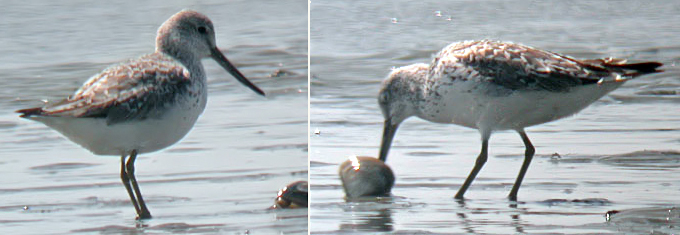
Eocheong Island, April 22
79 species logged. A very promising morning with heavy overcast and light rain showers, clearing in the afternoon, with strengthening northwesterly winds and again a sharp drop in temperature. A good selection of migrants, but still the sense that spring is a little late in coming...
Highlights included 2+ Greater Short-toed Lark and a Temminck's Stint at dawn, followed soon after by the Pied Wheatear still (perhaps gone by evening), close views in the harbor of a rather dishevelled Black-faced Spoonbill, 3 Red-billed Starling and one or two Northern House Martin and one Asian House Martin. Increased numbers of most species, with e.g. 3 Blue-and-White Flycatcher, 20 Pallas's Leaf and 20 Dusky Warblers, 2+ Grey and probably 25 Grey-backed Thrushes.

Eocheong Island, April 21 (pm)
Taking some rest time from the Monitoring Program (much needed after the terrible news that the Saemangeum outer seawall is now complete and that local media is absolutely oblivious of any of the environmental impacts...), a couple of days on Eocheong.
From the ferry just 4 Streaked Shearwater, while the afternoon on the island produced around 70 species, including a Long-tailed Rosefinch, 2 Chinese Blackbird, single Red-billed and Daurian Starlings, 7 Wryneck, a Greater Short-toed Lark, ca 75 Red-flanked Bluetail and 40 Siberian Stonechat, and in the late afternoon, a second calendar-year male Pied Wheatear (the second for Eocheong, and likely the fourth record for South Korea following one on the mainland earlier in the day!).
Sadly, no sign of the morning's Black Bittern.
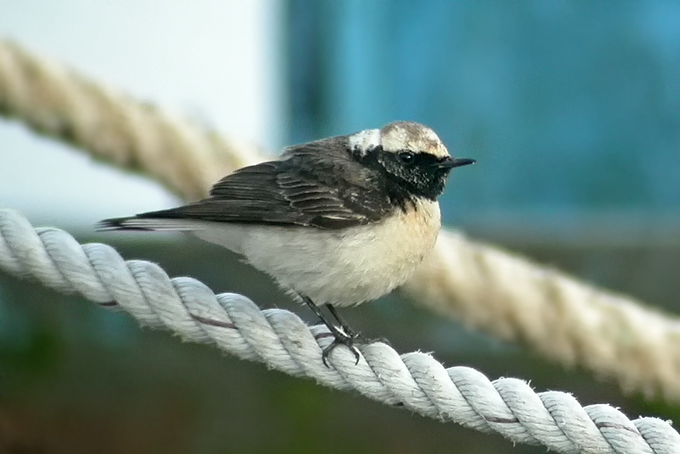

Gunsan, April 21
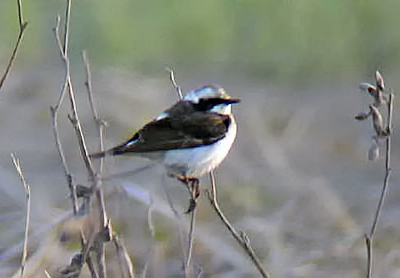
Pied Wheatear: First summer male, Gunsan (mainland), April 21: Peter Nebel, Angela Pacheco, Jim Levenson. This is considered the 4th Korean record, (and the 3rd record for South Korea).
Eocheong, April 21 (am only)
Finally, settled and sunny conditions, ideal for birding: a splendid Black Bittern was watched closely by both of us first thing in the morning, before taking cover in undergrowth by the stream. 2 Wryneck gave good views: there are now 3 Chinese Blackbirds and 1 Eye-browed Thrush. 2 female and 6 male Red Crossbills were in the pines. A Northern Goshawk appeared over the hillside. Elsewhere, 6 Green Sandpipers and a Rustic Bunting.
Heuksan Island, April 19 & 21
21 April: a male Yellow-bellied Tit (the fourth national record, with the first in late October 2005 on Socheong) and a male Grey Bushchat.
19 April: a male Citrine Wagtail.
Geum estuary mainland roost and Piin, April 20
In winds gusting to gale-force, after filming the site with AP, a search through the shorebirds found now 3 Nordmann's Greenshank (2 there on 19th), while coastal woodland held a very early Mugimaki Flycatcher, an Oriental Scops Owl and small numbers of the more expected migrants (e.g. Eastern Crowned, Pallas's and Yellow-browed Warblers).
Eochong, April 20


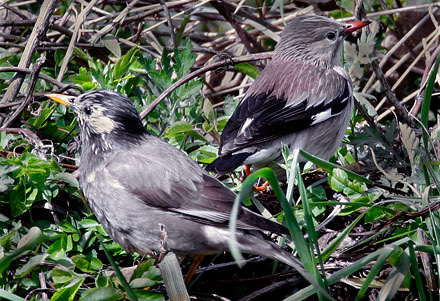
Photo © Robin Newlin
More gale-force winds appeared to keep numbers down: a lot of individual birds, but no fall of migrants as such.
1 Grey, 1 Grey-backed and 2 White's Thrush still, as well as the 2 Chinese Blackbirds and the Wryneck.
Also another Dusky, 2 Yellow-browed and 2 Eastern Crowned Warblers.
New birds included individuals of Chestnut-eared Bunting, Striated Heron, Chinese Grey Shrike, Great Spotted Woodpecker, Richard's Pipit, Hoopoe, and 4 Red-rumped/Striated Swallows.
Interestingly, a Japanese Lesser Sparrowhawk was mobbed by several Brown-eared Bulbuls, and a pair of Bull-headed Shrikes was observed catching and dismembering a hapless Goldcrest.
In the harbour, a Little Egret has been stationed with a lone Grey Heron for days, and 6 taimyrensis gulls included a possible barabensis Steppe Gull.
April 19, Eochong
Thunderstorms, rain and thick mist, and then very heavy cold winds made birdwatching difficult. 2 Brown-headed, 1 Grey-backed and 1 Grey Thrush, several more Red-throated Pipits, c. 10 Little and 1 Tristrams's Bunting, 1 Pallas's Leaf and one Dusky Warbler, were in evidence.
In the afternoon a Red-billed Starling joined 5 Grey Starlings, also a breeding-plumaged male Chinese Pond Heron, and possible Latham's Snipe frequenting the stream. A surprise Wryneck was joined by a Siberian Rubythroat, while a lone Black-faced Spoonbill sat on the rocks in the harbour, with 4 Great Crested Grebes nearby. The 2 Chinese Blackbirds are still showing well.
April 18th Eochong
Forceful winds continued: no change in the weather and similar birds to yesterday, however good views of now 2 Chinese Blackbirds to be had. New blow-ins included a Common Kingfisher, Wood Sandpiper, Oriental Reed Warbler, Grey Thrush (found dead), 2 Little Buntings, 1 Peregrine and a Northern Hobby.
In the harbour, the usual mixture of Temminck's Cormorants, Mongolian, Vega, Black-tailed, and a handful of taimyrensis Gulls.
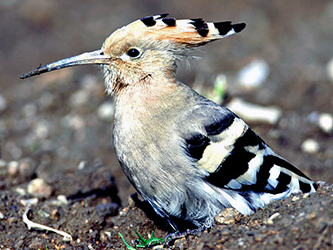

Photo © Robin Newlin
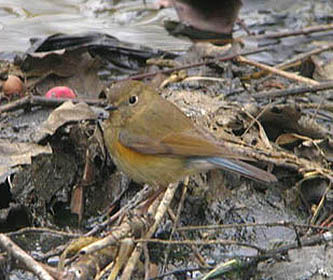
Photo © Tim Edelsten

Photo © Robin Newlin
Geum River Estuary, April 17

Photo © Nial Moores
Counting by three teams during the early morning spring high tide throughout the Geum Estuary (mainland and on Yubu Island) found 23 species and approximately 45000 individuals of shorebird (meeting several Ramsar criteria for identification as an internationally important wetland), with most numerous being Dunlin (16 370), Bar-tailed Godwit (12 460), Great Knot (10 429), Far Eastern Curlew (2 560), Grey Plover (2 194), and Eastern Oystercatcher (862).
In addition, on Yubu Island there were between 11 and 14 Nordmann's Greenshank and a possible Spoon-billed Sandpiper, along with a breeding-plumaged Black-faced Spoonbill and ca 25 Saunders's Gull.
Other migrants on Yubu Island included ca 25 Red-flanked Bluetail, 150 Brambling, 4+ Grey-backed Thrush, 4 Eastern Crowned and 2 Yellow-browed Warblers, single male Tristram's Bunting and female Siberian Blue Robin and an Intermediate Egret.



Eochong Island, April 17

Photo © Robin Newlin
Strong driving winds had pinned down abundant Dusky Thrushes (predominantly eunomus) and c.150+ Red-flanked Bluetail all over the island. Also sheltering in the conifers, 40-50 richly summer-marked Brambling.
Lesser numbers of other migrants included a scattering of Yellow, Grey, and leucopsis & (possibly one baicalensis) White Wagtails, 1 Red-throated and several Olive-backed and Buff-bellied Pipits. Many Siberian Stonechats, Coal Tits, Black-faced & Yellow-throated Buntings. Also present 3 Pallas' Leaf and 1 Eastern Crowned Warbler. Single birds included Goldcrest, Stub-tailed and Korean Bush Warblers, White's/Scaly Thrush, Green Sandpiper, Eurasian Wigeon, Grey-faced Buzzard, Eurasian Sparrowhawk, Hawfinch, Grey Starling, Asian House Martin, 2 Oriental Scops Owl (heard), several Barn Swallows and 2 Pacific Swift.
Highlights of the day were a Chinese Blackbird and - closely following Korea's first mainland record at Seosan on April 8th (see below) - another female Grey Bushchat, the fourth record of this national rarity this spring!

Mangyeung River (one team to Geum River estuary pm), April 16
With only 840 m of seawall still to build, the tidal-range has started to decrease in the Saemangeum system (by approximately 1.5 m), with the last afternoon high spring tide failing to inundate much of the higher areas.
Counts throughout the Mangyeung found 21 species and over 44000 individuals of shorebird (meeting several Ramsar criteria for identification as an internationally important wetland), with most numerous being Great Knot (25, 394), Dunlin (15, 625), Grey Plover (1, 325), Bar-tailed Godwit (1040), Far Eastern Curlew (788), Kentish Plover (472), Red-necked Stint (290) and Eastern Oystercatcher (85). In addition, there was a non-breeding plumaged Spoon-billed Sandpiper seen at close range, though briefly, by NM near the airport.
Approx. 15 flagged or banded birds seen during the day, within the Mangyeung and on the Geum estuary coastline (details to be posted soon).

Dongjin River (and Gomso Bay), April 15
Counts throughout the Dongjin on almost the last spring tide there - ever - found 23 species and over 24000 individuals of shorebird (meeting several Ramsar criteria for identification as an internationally important wetland). Most numerous were Dunlin (19,020), Bar-tailed Godwit (2, 326), Far Eastern Curlew ( 1, 343), Great Knot (293), Spotted Redshank (111), Eastern Oystercatcher (94) and Terek Sandpiper (91).
In stark contrast, the adjacent Gomso Bay (a site which developers claim will be used by displaced shorebirds) held a grand total of only 3 Eastern Oystercatcher and a single Grey Plover. In the afternoon, a successful spell looking for flags and bands in the Geum estuary with Kim Hyun-tae and family, and University birders Son Young-Sik and Yuk Min-Su.
Saemangeum and Geum, April 14

A day focused on confirming numbers of Great Knot present within the system, with teams counting 6 main areas. At the Mangyeung, 27000 Great Knot were off Okku (including one bird banded yellow over black on the right tarsus), with 450 more off the airport and 426 off Simpo, while there was also a total of 2 950 in the outer Geum: numbers apparently well down on those of e.g. 5-8 years ago.
Second most numerous shorebird encountered on the 14th was Dunlin, with a high count of ca 13000 on Yubu Island, where there were also e.g. ca 9000 Bar-tailed Godwit, 140 Eurasian Curlew, 300 Far Eastern Curlew, 378 Grey Plover, 63 Eastern Oystercatcher and 32 Sanderling, as well as 2 Temminck's Stint still and 45 Saunders's Gull.
Mangyeung and the Geum River Estuary, April 13
Counting effort was concentrated on the now highly threatened Geum estuary, as well as in the part of the Mangyeung system which was left unsurveyed on 12th. At one site in the Mangyeung, ca 12000 more shorebirds, with most numerous Great Knot (7500), Dunlin (4000), Grey Plover (450) and Far Eastern Curlew (375).
At the adjacent Geum, one team counted birds at both low and high tide on the mainland, while another team counted the high tide roost at Yubu Island. In total, over 53000 shorebirds counted, with most numerous being Dunlin (21 402), Bar-tailed Godwit (14, 756), Great Knot (13, 908), Grey Plover (1362) and Far Eastern Curlew (979). In addition, a range of interesting shorebird species included the Program's first Curlew Sandpiper, Green Sandpiper and Temminck's Stint (2), a probable (but very distant) Nordmann's Greenshank, and best of all, a full breeding-plumaged Spoon-billed Sandpiper (with likely a second individual in non-breeding plumage also present), seen by NM, JC and rather poorly by JSG.
Further species of note included possibly up to 40 Saunders's Gull in total, and on Yubu Island ca 20 Red-flanked Bluetail, 150 Brambling and a Grey-backed Thrush.
Saemangeum and Geum, April 12
With two teams counting from dawn until dusk, decent coverage of much of the area. Numbers obviously building, and tidal flow apparently somewhat restricted by the sea wall construction.
Most numerous species present in the Saemangeum system (minus extensive sand-flats near the airport which hosted at least 10000 shorebirds on April 2) today included Great Knot (28000), Dunlin (15, 670), Bar-tailed Godwit (1 970: almost all baueri, but including at least 3 menzbieri), Far Eastern Curlew (1 346), and Grey Plover (902), while the Monitoring Program's first Whimbrel (5) were logged, and species such as Sharp-tailed (ca 40) and Terek Sandpipers (55+) appear to be increasing daily.
Other species of note there included at least one Saunders's Gull, and some visible migration, including Red-throated (5), Olive-backed (5) and Buff-bellied Pipits (20), Chinese Penduline Tit (ca 30), and the personal first Yellow Wagtail of the spring.
On the Geum, 4 more orange leg-flagged Bar-tailed Godwits noted, all near the barrage.
Mokpo, April 12
A leg-flagged Bar-tailed Godwit seen and Photographed near to the Culture and Art Center in Mokpo City.

Hong Do Island, April 11

A Eurasian Crag Martin Ptyonoprogne rupestris seen and Photographed. This is the fourth record, following the first on Eocheong Island on April 29th 2002, 2 seen on Hong Island on April 20th 2003, and one on Hatei Island on May 27th 2004.
April 11: Spring 2006 - New Zealand-flagged Bar-tailed Godwits seen in East Asia
1RWYB. Chongming Island, Yangtze River, China, 30 March 2006. Zhang Kejia and coworkers. Captured, Photographed and released. Banded 22 October 2004 as an adult male, Avon-Heathcote Estuary, Christchurch, South Island, New Zealand.
4YWBB. Jeju Island, South Korea, 1 April 2006. Kan Chang-wan and Kim Eun-mee. Seen and Photographed. Banded 2 February 2006 as an adult male (418 g, so already putting on weight), Manawatu Estuary, North Island, New Zealand.
Seen there by Ian Saville on 4 and 17 March 2006, so maximum travel time of 15 days.2WBBY. Gan-no-su, Wajiro tidal flat, Fukuoka, Japan, 2 April 2006. Kouji Takenaka. Seen and Photographed in flock of 15 birds also including a New Zealand-flagged bird. Banded 17 November 2004 as an adult female, Firth of Thames, North Island, New Zealand.
Last seen in NZ on 22 March 2006, giving a maximum travel time of 11 days from NZ to Japan.4YYWW. Mangyeung River (Saemangeum), South Korea, 3 April 2006. Phil Battley, Nial Moores, John Geale. Banded 1 February 2006 as an adult male, Manawatu Estuary, North Island, New Zealand.
2YRRW. Keum River, South Korea, 3 April 2006. Phil Battley, Nial Moores, John Geale, Kevin & Kelly White. Banded 21 September 2004 as an adult female at the Firth of Thames, very light (264 g). Subsequently seen in the Bay of Plenty in NZ so had probably stopped short of its destination to refuel.
Possibly 2WYBY. Keum River, South Korea, 3 April 2006. Phil Battley, Nial Moores, John Geale, Kevin & Kelly White. Combination not confirmed.
2YRRW. Keum River, South Korea, 4 April 2006. Phil Battley, Nial Moores, John Geale, Kevin & Kelly White. Same bird as on 3 April.
2YBYY, Keum River, South Korea, 4 April 2006. Phil Battley, Nial Moores, John Geale, Kevin & Kelly White. Banded as an adult female, 5 October 2004, Firth of Thames, New Zealand.
Last seen Firth of Thames 24 March 2006, giving a maximum travel time of 11 days.3YYWB. Dongjin River, Saemangeum, Korea. 5 April 2006. Phil Battley, Nial Moores, John Geale, Kevin & Kelly White. Banded as a juvenile male on 13 December 2004 in Golden Bay, South Island, New Zealand.
This makes it just two years old and already migrating, probably the first time this has been documented in eastern Bar-tailed Godwits.3WWWY. Namdang-ri, Hongsung, South Korea, 5 April 2006. Kim Shin-hwan. Seen and Photographed. Banded on 16 November 2005 as an adult female, Tasman Bay, South Island, New Zealand.
3WWWY. Gung-ri, Hongsung, South Korea, 7 April 2006. Ahn Jung-hun and Jo Jung-jang. Same bird as above.
YY??. Ersari, Hongsung, 7 April 2006. Ahn Jung-hun. Photographed at distance; could be 2YYYB, seen on 9 April. Banded Firth of Thames, New Zealand, February-March 2004 if YY is correct.
2WW??. Abhae Island, Shinan, South Korea, 7 April 2006. Go Kyeng-nam. One of seven males banded 18 and 19 October 2004, Firth of Thames, New Zealand.
2RWRR. Abhae Island, Shinan, South Korea, 8 April 2006. Seen and Photographed. Banded 22 October 2005 as an adult male, Firth of Thames, North Island.
Last seen 25 March 2006 in the Firth of Thames, giving maximum travel time of 13 days.2RBRY. Abhae Island, Shinan, South Korea, 8 April 2006. Seen and Photographed. Female, first caught in the Firth of Thames, New Zealand, aged 2 in February 2000; caught again on 12 January 2005; caught again and colour-banded on 22 October 2005. This bird was colour-banded one bird after 2RWRR!
Last seen 22 March 2006 in the Firth of Thames, giving maximum travel time of 16 days.4YYYB. Ersari, Hongsung, 9 April 2006. Jo Jung-gang. Seen and Photographed. Banded as an adult male, 31 January 2006, Manawatu Estuary, North Island, New Zealand.
2YWW?. Ersari, Hongsung, 9 April 2006. Jo Jung-gang. Seen and Photographed. Could be 2YWWB, from the Firth of Thames, seen at Hongsung in a similar plumage in 2004 and 2005.
Jeju, April 10
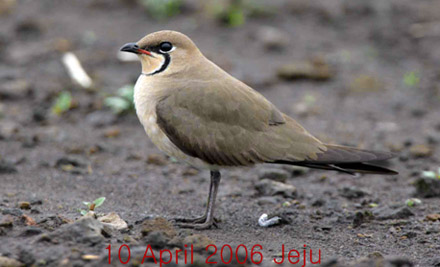
Photo © Hee-man Kang
First seen in Dejung-eup, Jeju on April 9 by Chang-wan Kang and Eun-mi Kim, this Oriental Pratincole was Photographed on April 10 by Hee-man Kang.
Dongjin and Mangyeung, April 11
After heavy overnight rain and a dull, wet morning, conditions gradually brightened, with excellent visibility - revealing the gap in the Saemangeum seawall to be now down to only a few hundred meters.
Counting at three points within the Saemangeum area produced 21 species of shorebird, with the first Broad-billed Sandpiper (2+) and Red Knot (1) of the Monitoring Program, increased numbers of Pacific Golden Plover (12), Terek (30) and Sharp-tailed Sandpipers (20), and probably betwen 15000 and 20000 Great Knot (with 8 730 counted on the Dongjin, and a very large flock seen at great range at the Mangyeung in the evening). Dunlin on the Dongjin included two counts of 4531 and 3270, while probably ca 6000 were also seen at the inner Mangyeung.
Other species of note included 5 Ruff still, at least 2 Saunders's Gull, 2 flagged Bar-tailed Godwit (one orange, one orange over green), and the same color-banded individual (yywb) as seen at the same site on April 5.
April 10, Inner Dongjin & Geum Barrage
In heavy rain and dank, dull conditions counting was limited to high tide at the inner Dongjin, and a two-point count by the Geum Barrage. 17 species of shorebird logged for the day, including three new for the Monitoring Program: Sharp-tailed Sandpiper (11 at Dongjin, 1 at the Geum), Wood Sandpiper (1 at the Geum), and Little Whimbrel (1 over the Dongjin: a very early record of this scarce migrant). At the Dongjin, on a still neapish high tide most numerous were Dunlin (1458) followed by Bar-tailed Godwit (368), Grey Plover (89) and Spotted Redshank (65), while also of note were 5 Ruff and now 6 Terek Sandpiper. At the Geum, on the north side of the barrage most numerous were Bar-tailed Godwit (167: 3 of which carried orange leg flags on the right tibia), Dunlin (898), Far Eastern Curlew (62) and Spotted Redshank (41).
Yubu Island, Geum estuary, April 9
Although tides were still more neap than spring, modest counts of 1025 Bar-tailed Godwit, 2645 Dunlin, 1438 Great Knot, 839 Grey Plover, 525 Far Eastern Curlew, 132 Red-necked Stint and 113 Eastern Oystercatcher, along with 5000 unidentified shorebirds (mostly Great Knot and Dunlin, 2 or 3 km distant), 6 Ruddy Turnstone, 4 Sanderling and 13 Saunders's Gull.
In woodland there, also a Eurasian Woodcock, ca 15 Red-flanked Bluetail, 8+ Dusky Thrush, 3 Asian Stubtail, 2 Pallas's Leaf Warbler and a male Blue-and-White Flycatcher, while there were around 70 Little Ter n offshore.
On the Mangyeung, even poorer tides, but still at least one Black-faced Spoonbill and a breeding-plumaged Pacific Golden Plover at "Crane point".
Yanggu, April 9

13 Garganey were seen on Seocheon in Yanggu, Gangwon-do. Down stream in the forest near Seocheon there is a rookery of Grey Herons and Great Egrets, and Little Ringed Plovers have arrived (one was seen making nest scapes on a sandbank).
A Striated Heron was also seen, the first this year in Yanggu area, and a male Falcated Duck and a female Tufted Duck at different places along the river.
Seosan, April 8
Highlights on Kim Hyun-tae's excellent website included a Greater Short-toed Lark (rare on the mainland), and a female Grey Bushchat: the first mainland record; only the seventh or so national record; but the third individual in South Korea this spring! (NB: Photos used with permission.)

Photo © KIM Hyun-tae
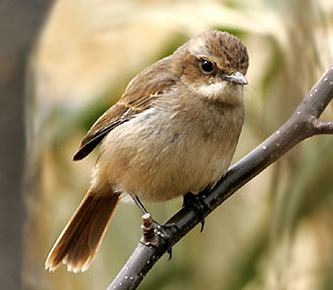
Photo © KIM Hyun-tae
Hong Do, April 4 - 8
First major national rarity of the month was a female Grey Bushchat, present (and Photographed) from April 4th or 5th - soon followed by a male on April 8! There are at least three previous national records.
Songdo, April 8
The handfuls of Chinese Penduline Tits and Olive-backed Pipits hang on at the edges of the lagoon. The nearby (very degraded, dried out and reclaimed) mudflat hosts less than a fraction of the birds that it did this time last year, but 5 Greater Scaup were notable.
On the mud at Ahamdo (where a broader section of tidal area remains), good to see 6 Black-faced Spoonbill and 62 Saunders Gulls, both species in fine breeding plumage. Numerous Kentish Plover were scattered over the sands, also 500+ Far Eastern Curlew, 13 Eastern Oystercatcher, ca 550 Dunlin, 7 Eurasian Curlew, 6 Grey Plovers, 5 Bar-tailed Godwits, 1 Common Sandpiper, and - surprisingly - still 3 or 4 Slaty-backed Gulls.
Inner Dongjin and Gomso Bay, April 5
(all counts approximate: more detailed data will be presented on spreadsheets at a later time)

In good morning light on a still reasonable tide 1527 Dunlin, 258 Bar-tailed Godwit (including another color-banded individual, this time a white flag on the left leg above yellow over yellow, with white over blue on the right ), 63+ Far Eastern Curlew, 51 Spotted Redshank, 3 Ruff, and the first Pectoral Sandpiper (a very scarce migrant through South Korea), Marsh Sandpiper and Pacific Golden Plover of the Monitoring Programme.
At midday, an hour-long drive south to Gomso Bay, a large sandy bay only 12 Km south of the outer part of the Dongjin. Counting at three points revealed very few shorebirds present, with only 13 Great Knot, 9 Far Eastern Curlew, 9 Dunlin and 7 osculans Oystercatcher. Birding highlights there included a stunning Black-faced Spoonbill, the personal first Red-rumped/Lesser Striated Swallow of the spring and excellent views by John of an adult male Red-flanked Bluetail.


Geum Barrage, April 4
(all counts approximate: more detailed data will be presented on spreadsheets at a later time)
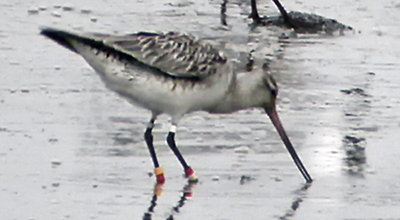
Heavy rain, the need to work on logistics etc, and a very useful meeting with leading activist Chu Yong-Gi (who informed us of the proposed reclamation of the Geum estuary, to start straight after the Saemangeum outer seawall is completed in late April), limited field work. In the early morning, John Geale watched a singing White's Thrush (giving both high and low notes) near our motel, while at the Geum barrage in the afternoon 3213 Dunlin, 455 Bar-tailed Godwit (including a new color-banded bird), and new for the Monitoring Program one Terek Sandpiper and 2 Black-tailed Godwit.
Mangyeung, Jeonju, Geum, April 3
(all counts approximate: more detailed data will be presented on spreadsheets at a later time)
At three count points in the inner Mangyeung, most numerous species were Dunlin (with counts of 2 495, 1990, and 955), Great Knot (1175, 260 and 40) and Grey Plover (232, 531 and 270), while a flock of 20 White Spoonbill contained 3 Black-faced Spoonbill (with one more Black-faced seen well in another area), and a group of 5 Saunders's Gull contained one individual with colour bands on both tibia. Also there, a frantically-feeding Bar-tailed Godwit (consuming 8 sizable worms in only 3 minutes), which was color-ringed with yellow over yellow on the left and white over white on the right, below a white flag.
In addition, a vocal group of 15 Hooded Crane watched going north, and still ca 1000 grey geese, including one heard but not seen which sounded identical to Greylag Goose.
In the afternoon, a trip to Jeonju to meet in two more international participants (Kelly and Kevin White), where also 2 Mandarin and 2 Long-billed Plover seen well. In the evening, 935 Bar-tailed Godwit (including several flagged and one or two more color-banded individuals) at the Geum barrage, while further up the coast at Janggu Bay 162 Far Eastern (including one leg-flagged bird) and 7 Eurasian Curlew, with a nearby roost also holding 2 Ruddy Turnstone, 2 Common Greenshank and 77 Kentish Plover, along with the more typical Dunlin and Far Eastern Curlew.
(With so many flag sightings, most will be posted separately)
Songdo, April 3
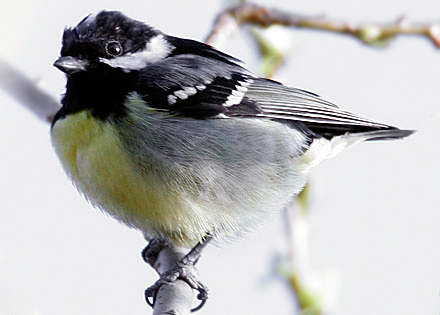
On the lagoon, a new influx of Black-headed Gulls is apparent, and in the reedy fringes, 1 Common Reed Bunting, 8 Chinese Penduline Tits and a Siberian Stonechat.
The nearby strip of reclamation mudflat hosted ca.10 Far Eastern and 1 European Curlew, as well as 2 Little Ringed Plovers and a pair of Barn Swallows heralding the spring. Overgrown scrubland at the golf course was especially productive: still 3 Chinese Nuthatch, 1 Long-tailed Rosefinch, 1 Tristram's Bunting, 1 Red-flanked Bluetail. In addition, a Great Spotted Woodpecker, 12 naumanni Dusky Thrushes, Coal Tits, a personal-record flock of perhaps 80 Vinous-throated Parrotbills, a few Goldcrests and Rustic & Yellow throated Buntings, and - amazingly - stunning views of the 'resident' Yellow-bellied Tit.

Keum River, Napo Village and East Eunpa Park, April 2
Five Bean Geese sheltered of the lee side of a riverine island out of the strong winds. At the Napo Reservoir a few dozen Falcated Ducks were seen. A Gadwall was there also. On the tidal flats a flagged Bar-tailed Godwit (Upper right flagged with orange; lower unknown, noted earlier by NM and CSH) returned as high tide approached then flew westward with its companions. In Eunpa Park the third of three encounters today with Siberian Stonechats provided a good view. Also there a couple of Hawfinch and a couple of dozen Dusky Thrush (all seen well were naumanni) were observed. Walking the ridge turned up a pair of White's/Scaly Thrush, which were also heard calling in that area. In the north east corner of Eunpa a single Garganey was seen.
Geum River, Saemangeum, April 2

Eungbong, April 1
Signs of Spring: Barn Swallows have arrived at Eungbong, along with greatly reduced numbers of Common Pochards, Tufted Ducks, Pintails, and Common Teal. However, the stream was brightened by 3 splendid Mandarin Ducks: a female attended by two males.
Geum River; Mangyeung, near Gunsan airport PM, April 2
A day overshadowed by the terrible news that the so-called developers intend to complete the Saemangeum seawall by April 24, when they will celebrate their incredible short-sightedness with some big event.
Otherwise, a morning of fog and logistical planning, followed by 2 hours at inner Geum, where ca 230 Bar-tailed Godwit including two males with orange flags on the upper right leg - one of which was Photographed by Mr.Chai Seung-Hoon.
At the Mangyeung near Gunsan airport, larger numbers of birds spread out over huge tidal-flats, with ca 8000 Dunlin and ca 1200 Great Knot most numerous. Also there, a single Common Greenshank, 2 Red-necked Stint and 4 Mongolian Plover - all the first of the spring for the team members.
April 1, Dongjin River, Saemangeum
Overcast, with heavy rain for much of the day. Limited counting included ca 1 160 Far Eastern Curlew (one with orange leg flags on upper right and left) at roost at Gyehwado, and 1 800 Great Knot and 8 420 + Dunlin at one roost near Simpo. In addition one Ruff, one Common Redshank and ca 6 Spotted Redshank also on the Dongjin, along with 2 White and one probable Black-faced Spoonbill, while other early spring migrants included one Osprey, ca 10 Barn Swallow, ca 8 Pacific Swift.
March 31, Yeongjong-Seosan-Mangyeung
Second of international counters, Dr. Phil Battley, arrived0800 am. ca 5 Saunders's Gull present on dropping tide, Yeongjong. At Seosan Lake A, 15 Bar-tailed Godwit, 10+ Far Eastern Curlew, 7 Saunders's Gull (also 7 Siberian Stonechat - another obvious sign of spring migration). 4 Km to south, at Hongseong, a high tide roost held 141 Bar-tailed Godwit (one with metal ring), one Great Knot and 56 Far Eastern Curlew, including one with orange flag on upper right and left legs.
At Okku, Mangyeung, last hour of daylight and high tide (apparently unrestricted by seawall construction still): shorebirds included 16 Bar-tailed Godwit, 111 Great Knot, 40+ Far Eastern Curlew.
March 30, Yeongjong
First of the international counters, John Geale, arrived late PM. Starex van rented for one month, arranged and paid for by members donations to Birds Korea (many thanks!). One hour at Yeongjong, southern end, found 31 Bar-tailed Godwit, ca 600 Far Eastern Curlew, 2 600 Dunlin and 50 Grey Plover. Also present 79 Saunders's Gull.





